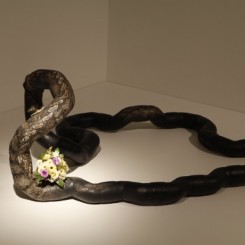“Indian Highway,” group exhibition with Ayisha Abraham, Ravi Agarwal, Sarnath Banerjee, Nikhil Chopra, Baptist Coelho, Sheela Gowda, Sakshi Gupta, Shilpa Gupta, Subodh Gupta, N.S. Harsha, Abhishek Hazra, M.F. Husain, Jitish Kallat, Amar Kanwar, Bharti Kher, Nalini Malani, Jagannath Panda, Hetain Patel, Prajakta Potnis, Raqs Media Collective, Tejal Shah, Sudarshan Shetty, Dayanita Singh, Kiran Subbaiah, Vivan Sundaram, Thukral & Tagra, Hema Upadhyay, Avinash Veeraraghavan, and Studio Mumbai Architects.
Ullens Center for Contemporary Art (798 Art District, No. 4 Jiuxianqiao Road, Chaoyang District, Beijing). Jun 24 to Aug 26, 2012.
UCCA served up Indian takeaway this summer: more specifically a show from the Serpentine in London, which has already been to Oslo, Rome and Lyon, finally touched down in Asia. Having traveled thus far, perhaps it is unsurprising that some of the carefully crafted dishes (some 200 works by 30 artists) cooled slightly, even with such curatorial couriers as “HUO” (Hans Ulrich Obrist) and Julia Peyton-Jones — all plated up by the UCCA team. In China’s contemporary art hotplate that prefers to look only at its own output, not that of others, reheating “Indian Highway” was not a lightweight task.
The arrival of “Indian Highway” is the boldest statement yet of UCCA’s international impetus, and thankfully it is on a level removed from the one-dimensional low of the New Yorker photographic exhibition.
It might be a relatively thankless exercise for now, where the embrace of the international is very incomplete. Whilst Chinese art is content to export itself, it is largely unconcerned with importing that of anyone else, and less another nation increasingly called its fellow. India is a country with which dotted parallel lines might be drawn as a zone of goliath socio-economic change in recent years. One anticipated from the wall text that stock phrase, “rapid urban development,” but found instead a more weighty mention of Glissant’s theory of mondialité. But such co-ordinates may do little to warm this unprecedented event on Chinese soil. Among those Indian artists present at the opening, Sudarshan Shetty and Dayanita Singh remarked of knowing nothing of Chinese contemporary art; and one detected a dismissive reception amongst local Chinese artists not much bothered about entertaining the works’ ideas and context. Thus, the question raised in the wall text, “What would a world look like in which the ascendant powers of Asia look not to the West, but at each other?” came across rather like a Serpentine script, even as one resisted the urge to note the difference between looking “to” and looking “at.”
